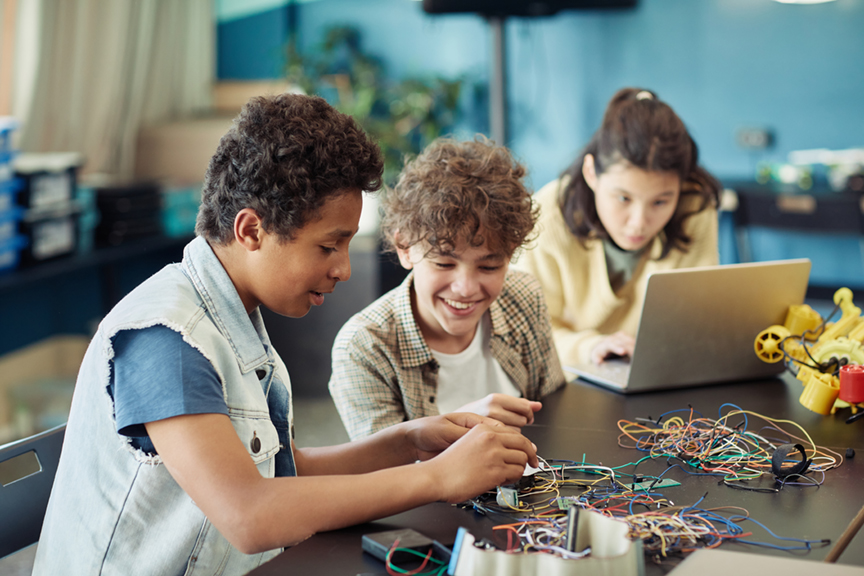
Use empathy and invention to help the main character(s) of a novel.
A Grade 7 teacher wanted to engage his learners in an interdisciplinary study focused on human rights, using powerful literature and a STEAM approach. Leading up to this, the Grade 7 learners had been exploring the topic of human rights through a variety of texts including articles, websites, videos, interviews, and a podcast. They had explored the United Nations Convention on the Rights of the Child and taken part in a mini-inquiry related to some of the individual rights that interested them. As the class moved into this new phase of study, the teacher started with a read-aloud of the picture book Nya’s Long Walk by Linda Sue Park. This is a story about Nya who lives in South Sudan, and, like many girls in her village, she has the very strenuous job of fetching water for her family from a remote water hole.
Using this book to introduce the concept of novel engineering, the teacher explained how they would be working through each step of the novel engineering process together using this story before they would then work through a similar process in small groups reading related novels. He also explained how they would be using the design thinking process of the launch cycle (A. J. Juliani and John Spencer) to guide their work and that they will be working through the following phases:
First, the teacher and learners created a character profile for Nya, the main character of the text, including both her physical traits and the characteristics of her as a person. Next, he asked the learners to describe the problem that Nya faces in the story or the goal that she is trying to achieve. The class determined that Nya’s problem is that, while on the long trek to get water for her family, her sister gets sick and can walk no further.
Pausing at the part in the story where the problem was revealed and noted by the learners, they discussed what they were thinking and questions they had. The teacher then sent them off in small groups of four to ideate and come up with three to five creative solutions to help the main character solve the problem, which they shared with the class. Some of the inventive and innovative ideas they came up with included magical shoes that allowed Nya to transport from one place to another while carrying her sick sister, walkie-talkies that would let Nya contact someone in the village to come and help, a clean water system that would mean Nya would not have to walk so far in the first place, a miracle drug that would make her sister instantly better, and so on. From there, the teacher tasked each group with choosing one of their ideas and coming up with a design plan for how they would create their idea and make it a reality. Once they had a plan, it was time to build and create a prototype, using both art or construction materials, technology, or different modes. After the groups completed their first prototype, they shared it with each other and the teacher to glean feedback used to improve their design.
In the next phase of this learning experience, the teacher completed book talks on novels with human rights themes. After hearing about all the potential books, learners recorded their top choices to read, and the teacher grouped them in literature circles determined by their choices. Next, the learners spent a few weeks reading their assigned book and working together through the novel engineering steps and design thinking process based on the main character’s needs, in turn inventing a solution to help and support them through the lens of empathy. Each novel team also explored the human rights theme evident in their book and shared their observations related to it with the class. At the novel’s end, all the teams’ inventions were shared in a STEAM showcase, during which the team members shared their inventions and reflections on their process.
For a visual representation of the LAUNCH Cycle design thinking framework, visit https://spencerauthor.com/wp-content/uploads/2016/05/the-launch-cycle-color.png.
Also, visit #novelengineering on X or Instagram for examples of learner work.
Human Rights Resources
D’Adamo, Francesco. Iqbal. Aladdin, 2001.
Ellis, Deborah. The Breadwinner. Groundwood Books, 2000.
Jordan-Fenton, Christy, and Margaret-Olemaun Pokiak-Fenton. Fatty Legs: A True Story. Illustrated by Liz Amini-Holmes, Annick Press, 2010.
Park, Linda Sue. Nya’s Long Walk: A Step at a Time. Illustrated by Brian Pinkney, Clarion Books, 2019.
Yousafzai, Malala. I Am Malala: The Girl Who Stood Up for Education and Was Shot by the Taliban. Little, Brown and Company, 2013.